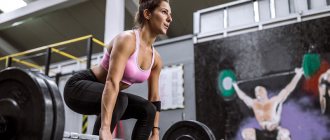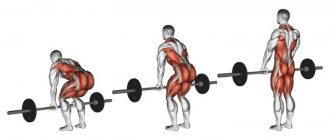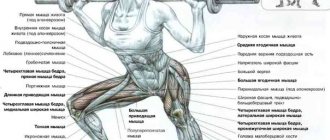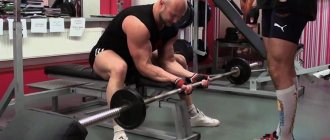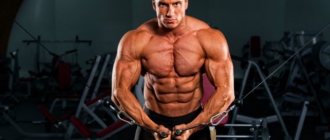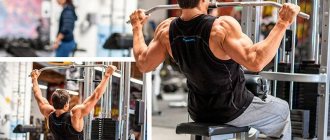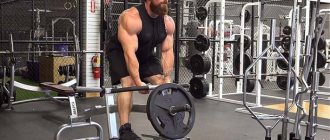Deadlifts from a pit or deadlifts from an elevation are one of the special preparatory exercises for powerlifting. It serves to improve the lifting of the barbell from the platform. Helps develop take-off, kick drive and quadriceps function when lifting the apparatus off the floor. A variation of this deadlift is also used in fitness, when you need to use your legs more on the deadlift and take the load off your back. In weightlifting, it is used to develop movement speed. It is necessary to learn how to deadlift from a pit after you have mastered the competitive technique of this exercise, that is, deadlift from a platform.
Preparing the platform
In clubs where there is no platform, it is recommended to perform deadlifts on a rubber floor or any other non-slip surface. This will protect you from falling. Specialized plinths for pit traction are made of wood or rubber, but they are not available everywhere. They can be replaced with improvised material. If there is nothing at all in the club and the discs are not standard for strength training, but bumper plates or rubberized, it is worth collecting your working weight with discs of a smaller diameter.
Execution technique
Initial position
- It is not justified to use a plinth that is too high. The ideal height is no more than 8 cm, anything more is an extra burden on the legs;
- Plinths or stands must be installed on the platform so that they do not slide if the sumo technique is used;
- In halls where there are no stands, wide disks can be used; for most people, 1-2 disks of 15 kg each, placed one on top of the other, are enough;
- The barbell is assembled onto competition plates and placed on the platform so that its center coincides with the imaginary center where the athlete can stand;
- The position of the feet duplicates the position in the competitive movement, those athletes who pull in the classics should remain in it, those who pull in sumo - similarly;
- The grip in classic is slightly wider than the hips, in sumo it’s the opposite;
- Make sure your grip remains symmetrical
- You should actively turn on your back, first you need to tighten your arms, and then tone your lats, and take a deep breath, as if closing the air inside;
- Then you should firmly rest your feet on the platform, distributing the weight between your heel and toe.
Movement
- Traction is extension of the knee and hip joint simultaneously;
- You need to imagine as if you are strongly pushing the ground with your feet;
- As soon as the bar reaches the knee, you should sharply straighten the knee joints;
- The projectile will “go” to the level of the pockets by inertia, and you only need to simultaneously move your shoulders and bring your pelvis to a neutral position.
Deadlift standing on a stand: execution technique
Powerlifting world records
Deadlift record
Benedict Magnuson (or simply Benya, as Russian powerlifters call him) was born on July 4, 1983. At the age of 16, I went to the gym to recover from a spinal injury. He recovered so much that in 2011 he set a world record in deadlift at the Ronnie Coleman classic tournament. 1015 pounds or 460 kg, with only a belt as equipment - this is the result given by a guy with a once problematic spine. The Icelander's height is 183 cm, weight at the time of the record is 172 kg. Many still believe that Magnuson could have taken heavier weights.
Bench press record
The bench press is not officially considered an indicator of strength in classical powerlifting, although there are championships for this exercise, and the usual question for a bodybuilder or powerlifter is: “How much do you bench press?” If you are still benching a small weight, feel free to answer that it is less than Ryan Keneally. This American set a world record in the bench press, lifting 487.6 kg in equipment. It’s interesting that the guy came to the bar after he was kicked out of all sports sections, and then from school. Ryan started with 96 kg. So when asked about weight, simply answer: “I’ll catch up with Keneally soon!”
Video of Ryan Keneally's record:
Barbell squat record
Squats are not considered a separate discipline, and are usually included in the classic triathlon of powerlifting for qualification. But nothing prevents the “jocks” from setting records in this exercise. Moreover, one record here belongs to our compatriot, and the second record belongs to a resident of Moscow.
Vladislav Alkhazov
Vladislav Alkhazov moved from the USSR to Israel as a child, where he began performing in the IPA. It was in this federation that Alkhazov squatted with 567 kg on his shoulders, setting a world record in equipment.
Andrey Malanichev
Muscovite Andrei Malanichev set a record of 450 kg in squats with a barbell on his back in bandages. In total, this already legendary powerlifter has 5 Russian records, the 2008/2009 Titan Cups and the title of absolute champion of Russia in 2005.
Records in weight categories
Sergey Feodosienko
Since 2012, the record in the bench press and deadlift, as well as the total weight of the triathlon, belongs to the Russian Sergei Fedosienko (160, 270 and 651 kg, respectively), but the American Koons Michael (225 kg) surpassed Sergei in the squat. Both athletes competed in the up to 59 kg category.
Recommendations
- The bar should be non-slippery, ideally competitive. If there is none in the hall, use straps;
- You should wrap your back in the same way as you would for a regular competition deadlift;
- The weak point of this row is the need to pull the weight from a point that is lower than usual, therefore a significant risk of rounding the back accompanies the exercise;
- It is not worth “inserting” the thoracic region rigidly because its deflection in the opposite direction leads to overload of the lower back and injury;
- The lumbar region should be rigid in the deadlift. The chest can just be slightly bent, creating the effect of a fishing rod;
- The shoulders calmly move forward and drop slightly.
Deadlift technique video
Errors and recommendations:
- You need to make sure that your back does not round while performing power pulls, otherwise this may lead to a spinal injury. When your back rounds, you need to stop and lose weight.
- The barbell should move as close to the legs as possible - this will help reduce the load on the spine. Never do deadlifts if you have an injured back or a herniated disc.
- Be consistent, do not make sudden movements and do not throw the barbell, slowly lower and raise the weight. Sudden removal of the load can severely impact the back muscles, elbows or shoulders. It is likely that you will not feel anything at first, and the injury will appear after a couple of days.
- Your gaze should be straight ahead or slightly higher, and do not lower your chin while performing the deadlift.
- When lifting, as well as lowering the barbell, it is forbidden to transfer your body weight to your toes - the bar will slip forward from your legs, and you may get injured.
- You should avoid forceful traction “bouncing” from the floor surface. This will make your work much easier and speed through the most critical point of execution. The essence of this training will then completely disappear. This can lead to asymmetrical lifting of the weight and uneven load on the body, which can lead to serious spinal injuries.
- You shouldn't do reps on powerlifts "to failure." There should be no unwanted forcing or unnecessary repetitions. In such a serious complex, such experiments are completely undesirable.
- You shouldn't deadlift when your lower back muscles are sore from your last workout, and not too bad. Rest and wait for the muscle pain to subside.
- Sometimes when lifting a lot of weight, your blood pressure jumps a lot. In this case, it is advisable to tighten the headband tightly. It is preferable to use an elastic bandage so that pressure changes are felt less acutely.
- If necessary, you can use a weight belt to stabilize your back.
- If your grip is still weak and you are afraid that the bar may slip out, use wrist straps when performing deadlifts.
- Perform the exercise in shoes with thin soles or on bare feet.
- Apply chalk or magnesium to your hands, preferably before each approach.
- It is better to select the starting weight so that you can perform the exercise about fifteen times.
Inclusion in the program
Deadlifts from a stand are included on the day of special preparatory exercises if the athlete trains deadlifts 2 times a week, and on a regular training day immediately after the main deadlift if once.
The weight of the weight is determined as a percentage of the one-repetition maximum, and should not exceed 60-70 percent. Ideally, the exercise is done in 15-18 lifts, dividing the total number into 3-5 repetitions per set. But there are also supporters of “building classics” who do 3-4 sets of 8 repetitions with light weights.
If deadlifting starts your session, a specific warm-up is required. It is logical to perform several sets of regular deadlifts from a platform with a light weight, and only after that stand on a block, stand, or plate. This will help warm up the joint and improve mobility.
In other cases, a regular deadlift or one of the variations is enough to achieve the desired effect for warming up.
The rack row is sometimes performed with a band to add resistance at the top of the movement. Then it allows you to improve not only the stall, but also the reach, in which case the deadlift is an excellent option for anyone who needs to work on both phases of the movement.
It must be remembered that special preparatory exercises can and should vary. You don't have to do all your deadlifts from a stand. Sometimes it is worth doing them with stall stops and other technical variations in order to improve both strength and movement dynamics.
Powerlifting: Understanding the Varieties of Deadlifts
Absolute records in deadlift are recorded at powerlifting and extreme strength competitions. Why records? Because the traction in these sports disciplines is different.
The most obvious are “sumo” and “classic”. In powerlifting, both options are allowed, in extreme strength only classics are allowed, but the rules for performing the movement themselves are different - in strong, straps, double movements and support on the hips are allowed. Thus, one reason for dividing records has already been determined. The second will be equipment, but only for extreme power lifting. It so happened that the highest achievement in powerlifting was shown without it. The third reason is what this post focuses on - the equipment used. In powerlifting there are two options:
The strictest is the neck from the Eleiko company. It is very rigid, the shortest and practically does not bend even at 400 kg. Length - 2200 mm, diameter - 29 mm. Now this bar is used only in IPF competitions. Its alternative brother is the Texas deadlift bar. Softer, longer, thinner. Length - 2300 mm, diameter - 27 mm. The question arises: what gives softness and length? On a soft bar, the athlete, with a starting movement, pulls on the bar, the elastic properties of which create additional upward inertia; the discs lift off the floor only at the moment when part of the movement has already been completed.
Compare the sumo deadlift of 390 kg on a hard bar from Andrey Konovalov and on a soft bar from Dmitry Nasonov. Even the difference in the height of athletes will not hurt to evaluate how the use of a soft bar reduces the amplitude of movement and changes its dynamics:
Let's take the two highest achievements in powerlifting in terms of the equipment used: Benedikt Magnusson pulled 460 kg on a soft bar, Krzysztov Wierzbicki - 420 kg on a hard bar. The absolute record is Benedict's result, although these are two completely different records, and here a division would be very appropriate, but there is none.
In power extremes, they pull on a soft Texas, and on a hard Axel, and on a long Rogue Elephant bar, and on an even longer bar without a name, where modified Hummer wheels are hung instead of discs. Fortunately, now absolute records are recorded only on the soft bar and the new Elephant bar. The remaining options are either used in multi-repetition competitions, or are no longer used at all.
There are also two main records here - 500 kg on a standard soft bar from Eddie Hall in equipment and 474 kg on a three-meter, no less soft, Elephant bar from Hafthor Bjornsson without equipment.
It's interesting how the line between these two records has begun to blur. Different bars and equipment did not prevent Hafthor from making an attempt at 501 kg, laying claim to Hall’s record. Now Bjornsson is preparing for the Arnold Classic 2020 tournament, where he will probably make another attempt.
Bottom line
- Records from powerlifting cannot be mixed with records from extreme strength sports.
- There are three absolute records in the deadlift, two can merge together, and one would be worth dividing into two.
- There are only more equipment options and it will become more and more difficult to deal with them.
